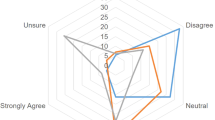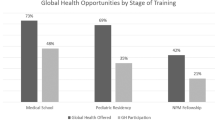Abstract
Objective:
To study trainee and supervisor perspectives for success or failure of conversion of abstracts to full manuscripts.
Study Design:
Abstracts presented by trainees between 2000 and 2005 were identified from the syllabi of the Paediatric Academic Society, Canadian Paediatric Society and Hot Topics meetings. The trainee and senior supervisor for each abstract were asked to complete a web-based survey that explored enablers and disablers.
Result:
Of the 187 abstracts identified, 62 (33%) had trainees as primary authors. Of these, the responses of 42 (68%) trainees and 50 (81%) supervisors were collected; the responses of 21 (50%) trainees and 19 (38%) supervisors reported success in converting the abstract to a manuscript. According to trainees, good research idea, supportive supervisors and practical design were the main enablers, whereas limited time for research and the limited data collection only for abstracts were the main disablers. According to supervisors, adequate research time and the trainees' interest were the main enablers, whereas limited data collection and lack of trainees' interest were the main disablers. Specified research training, allocation of protected research time and making publication mandatory were suggested by both to enhance publication rate.
Conclusion:
Training programs should consider research training needs and provide dedicated time to improve research productivity by trainees.
This is a preview of subscription content, access via your institution
Access options
Subscribe to this journal
Receive 12 print issues and online access
$259.00 per year
only $21.58 per issue
Buy this article
- Purchase on Springer Link
- Instant access to full article PDF
Prices may be subject to local taxes which are calculated during checkout
Similar content being viewed by others
References
Riordan FA . Do presenters to paediatric meetings get their work published? Arch Dis Child 2000; 83: 524–526.
Daluiski A, Kuhns CA, Jackson KR, Lieberman JR . Publication rate of abstracts presented at the annual meeting of the Orthopaedic Research Society. J Orthop Res 1998; 16: 645–649.
Gorman RL, Oderda GM . Publication of presented abstracts at annual scientific meetings: a measure of quality? Vet Hum Toxicol 1990; 32: 470–472.
Nguyen V, Tornetta III P, Bkaric M . Publication rates for the scientific sessions of the OTA. Orthopaedic Trauma Association. J Orthop Trauma 1998; 12: 457–459; discussion 456..
Byerly WG, Rheney CC, Connelly JF, Verzino KC . Publication rates of abstracts from two pharmacy meetings. Ann Pharmacother 2000; 34: 1123–1127.
Scherer RW, Dickersin K, Langenberg P . Full publication of results initially presented in abstracts. A meta-analysis. JAMA 1994; 272: 158–162.
Jackson KR, Daluiski A, Kay RM . Publication of abstracts submitted to the annual meeting of the Pediatric Orthopaedic Society of North America. J Pediatr Orthop 2000; 20: 2–6.
Bhandari M, Devereaux PJ, Guyatt GH, Cook DJ, Swiontkowski MF, Sprague S et al. An observational study of orthopaedic abstracts and subsequent full-text publications. J Bone Joint Surg Am 2002; 84-A: 615–621.
Juzych MS, Shin DH, Coffey JB, Parrow KA, Tsai CS, Briggs KS . Pattern of publication of ophthalmic abstracts in peer-reviewed journals. Ophthalmology 1991; 98: 553–556.
Wang JC, Yoo S, Delamarter RB . The publication rates of presentations at major Spine Specialty Society meetings (NASS, SRS, ISSLS). Spine (Phila Pa 1976) 1999; 24: 425–427.
Hamlet WP, Fletcher A, Meals RA . Publication patterns of papers presented at the Annual Meeting of The American Academy of Orthopaedic Surgeons. J Bone Joint Surg Am 1997; 79: 1138–1143.
De Bellefeuille C, Morrison CA, Tannock IF . The fate of abstracts submitted to a cancer meeting: factors which influence presentation and subsequent publication. Ann Oncol 1992; 3: 187–191.
Eloubeidi MA, Wade SB, Provenzale D . Factors associated with acceptance and full publication of GI endoscopic research originally published in abstract form. Gastrointest Endosc 2001; 53: 275–282.
Hashkes P, Uziel Y . The publication rate of abstracts from the 4th Park City Pediatric Rheumatology meeting in peer-reviewed journals: what factors influenced publication? J Rheumatol 2003; 30: 597–602.
Kiroff GK . Publication bias in presentations to the Annual Scientific Congress. ANZ J Surg 2001; 71: 167–171.
Klassen TP, Wiebe N, Russell K, Stevens K, Hartling L, Craig WR et al. Abstracts of randomized controlled trials presented at the society for pediatric research meeting: an example of publication bias. Arch Pediatr Adolesc Med 2002; 156: 474–479.
Landry VL . The publication outcome for the papers presented at the 1990 ABA conference. J Burn Care Rehabil 1996; 17: 23A–26A.
McCormick MC, Holmes JH . Publication of research presented at the pediatric meetings. Change in selection. Am J Dis Child 1985; 139: 122–126.
Callaham ML, Wears RL, Weber EJ, Barton C, Young G . Positive-outcome bias and other limitations in the outcome of research abstracts submitted to a scientific meeting. JAMA 1998; 280: 254–257.
Davies MW, Dunster KR, East CE, Lingwood BE . Fate of abstracts published in the proceedings of the first annual Perinatal Society of Australia and New Zealand Congress in 1997. J Paediatr Child Health 2002; 38: 501–506.
Evers JL . Publication bias in reproductive research. Hum Reprod 2000; 15: 2063–2066.
Levett PN . Converting conference presentations into publications. West Indian Med J 2000; 49: 197–199.
Stolk P, Egberts AC, Leufkens HG . Fate of abstracts presented at five International Conferences on Pharmacoepidemiology (ICPE): 1995 to 1999. Pharmacoepidemiol Drug Saf 2002; 11: 105–111.
Timmer A, Hilsden RJ, Cole J, Hailey D, Sutherland LR . Publication bias in gastroenterological research—a retrospective cohort study based on abstracts submitted to a scientific meeting. BMC Med Res Methodol 2002; 2: 7.
Sprague S, Bhandari M, Devereaux PJ, Swiontkowski MF, Tornetta III P, Cook DJ et al. Barriers to full-text publication following presentation of abstracts at annual orthopaedic meetings. J Bone Joint Surg Am 2003; 85-A: 158–163.
Walia R, Ohlsson A . Outcome of abstracts submitted for Annual Conference of the American Pediatric Society and the Society for Pediatric Research (APS-SPR)- limited to randomized control trials in neonatology. Pediatr Res 1999; 45: 231A.
Ariagno RL . National Institute of Child Health and Human Development (NICHD) and American Academy of Pediatrics (AAP) workshop on research in neonatal and perinatal medicine. J Perinatol 2006; 26 (Suppl 2): S3–S4.
Ariagno RL . Survey of neonatology training programs: 2002 to 2003. J Perinatol 2006; 26 (Suppl 2): S38–S45.
Scherer RW, Langenberg P, von Elm E . Full publication of results initially presented in abstracts. Cochrane Database Syst Rev 2007; (2): MR000005.
Krzyzanowska MK, Pintilie M, Tannock IF . Factors associated with failure to publish large randomized trials presented at an oncology meeting. JAMA 2003; 290: 495–501.
von Elm E, Costanza MC, Walder B, Tramer MR . More insight into the fate of biomedical meeting abstracts: a systematic review. BMC Med Res Methodol 2003; 3: 12.
Euser AM, Zoccali C, Jager KJ, Dekker FW . Cohort studies: prospective versus retrospective. Nephron Clin Pract 2009; 113: c214–c217.
Diezel K, Pharoah FM, Adams CE . Abstracts of trials presented at the Vth World Congress of Psychiatry (Mexico, 1971): a cohort study. Psychol Med 1999; 29: 491–494.
Dyson DH, Sparling SC . Delay in final publication following abstract presentation: American College of Veterinary Anesthesiologists annual meeting. J Vet Med Educ 2006; 33: 145–148.
Grzybowski SC, Bates J, Calam B, Alred J, Martin RE, Andrew R et al. A physician peer support writing group. Fam Med 2003; 35: 195–201.
Stepanski LM . Becoming a nurse-writer: advice on writing for professional publication. J Infus Nurs 2002; 25: 134–140.
Sommers PS, Muller JH, Bailiff PJ, Stephens GG . Writing for publication: a workshop to prepare faculty as medical writers. Fam Med 1996; 28: 650–654.
Bydder S, Packer D, Semmens J . The value of a scientific writing training workshop for radiologists and radiation oncologists. Australas Radiol 2006; 50: 29–32.
Hekelman FP, Gilchrist V, Zyzanski SJ, Glover P, Olness K . An educational intervention to increase faculty publication productivity. Fam Med 1995; 27: 255–259.
Steinert Y, McLeod PJ, Liben S, Snell L . Writing for publication in medical education: the benefits of a faculty development workshop and peer writing group. Med Teach 2008; 30: e280–e285.
Author information
Authors and Affiliations
Corresponding author
Ethics declarations
Competing interests
The authors declare no conflict of interest.
Additional information
Presented at the Annual Meeting of Pediatric Academic Society, Vancouver 2010 and Canadian Pediatric Society, Vancouver 2010.
Supplementary Information accompanies the paper on the Journal of Perinatology website
Supplementary information
Rights and permissions
About this article
Cite this article
Nasef, N., Skidmore, M. & Shah, P. Enablers and disablers allowing trainees' abstracts to proceed to full manuscripts: lessons from a large neonatal training program. J Perinatol 31, 411–416 (2011). https://doi.org/10.1038/jp.2010.140
Received:
Revised:
Accepted:
Published:
Issue Date:
DOI: https://doi.org/10.1038/jp.2010.140



